and time information at the bottom border
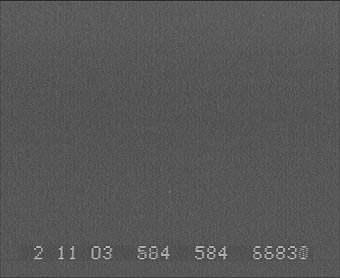
Video picture - structure and timing
Each video picture in the PAL or in the NTSC system consists of two half-images. With the first half-image only the odd lines 1, 3, 5, 7 ... etc. will be transfered up to the bottom image border. With the second half-image then the lines 2, 4, 6, 8 ... etc. follow likewise up to the bottom image border. Thus with the PAL system with 50 half-images per second altogether only 25 frames per second are transferred. With this picture transmission procedure one achieves an apparently double picture frequency without to strong picture flares and without increase amount of data.
With the PAL system every 20 milliseconds (ms) a half-image is transferred. Before each odd and even half-image an own and differently vertically sync impulse is sent. So all television sets can detect the beginning of the two half-images accurately and again correctly build the odd and even rows up in real time to a frame. In this way all 40 ms a complete frame with all rows is transferred. Thus one reaches 25 frames per second.
Time insertion in video picture with GPS + time inserter KIWI-OSD
The KIWI-OSD developed by Geoff Hitchcox from Christchurch in New Zealand can receive the world time UTC with an accuracy within the microsecond range (1/1000000 s) using a Garmin GPS modul 18 LVC. With this equipment then the accordingly exact time information can be faded in into any video signal (PAL or NTSC). Beside from the
usual time also the time intervals are faded in since the last second start and the time of the two last Vsync impulses of the odd and even half-images with the accuracy of a 1/1000 second (1ms). A continuous counter at the right lower border counts all half-images of the video signal and facilitates so additionally the later time evaluation.
| Downsized video picture with a star and time information at the bottom border  |
This picture shows which information is faded in at each bottom border  |
HH Hours (UTC) MM Minutes SS Seconds EEE ms at E-VSync of the half screen with even rows (Even 2, 4, 6, ...) OOO ms at O-VSync of the half screen with odd rows (Odd 1, 3, 5, ...) FFFFF Counter for all video half-images (Fields) since starting.
The accurate chronological allocation of the half-image (Field image), represented above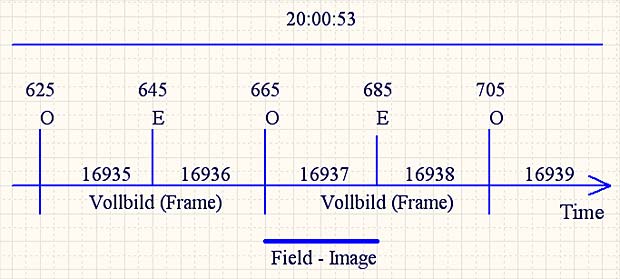 |
If now an event in such a half-image (Field image) were acquired, one can specify the exact time of the event within a range from 20ms. For the example picture thus the following definition results:
Field Image 20h 00m 53,675s +/-10ms (20:00:53,665 - 20:00:53,685) UTC.The recording and evaluation in individual half-images represent the momentarily possible optimum within the normal video range. All events can be exactly assigned thereby in the PAL system at least on +/- 10ms.
Videorecording
Unfortunately individual video half-images are however usually noted by most video recorders but not of usual digital videograbber. Only few digital solutions offer the possibility of a genuine half-image recording and half-image replay with their software drivers also. Usual video recorders sometimes represent a substantial problem due to the weight, their size and the energy consumption at a mobile use. Some portable constructions or Camcorder types with analogue input are suitable here as usable replacement.
Video picture evaluation
For Video picture evaluation of a video tape recording in the half-image mode one however absolutely needs a special video recorder of the elevated class. Only with these devices with more genuinly "video cut ability" in the fixed image mode one can step with a "Jog wheel" from half-image to half-image without damageing video head or video tape. Here is a short list of video recorders wich were told to me as useable to handle half-images. But only my own Panasonic NV-HS 950 was tested by me until now. If you know another one please email me to include the device in this list.
Blaupunkt RTV-950 Hifi = Panasonic NV-FS 200 Blaupunkt RTV-959 S-VHS = Panasonic NV-FS 200 EG Panasonic NV-FS 200 = Blaupunkt RTV-950 Hifi Panasonic NV-FS 200 EG = Blaupunkt RTV-959 S-VHS Panasonic NV-HS 950 EG Panasonic NV-HS 1000 EG Panasonic NV-HS1000BYP Many thanks to all who have informed me up to now about this video-recorder types.
Panasonic NV-HS 950 used for Video half-image evaluation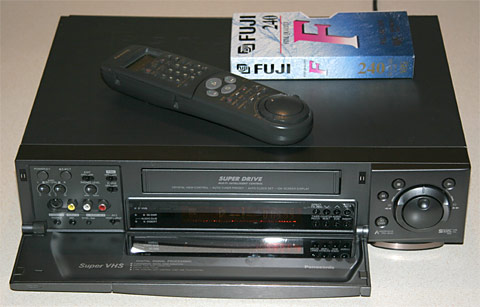 |
Video recording and picture evaluation with an external USB Videograbber
With my Notebook and the external Xpert v-Stream Videograbber USB2.0 I can accomplish videorecording on hard disk without frame loss. During this recording in AVI-format in each case two sequential half-images are stored and can be separated later with the right software during replay. Thus later an allocation of an event with an accuracy of +/- 10ms is possible.
| USB2.0 Videograbber Xpert V-Stream for direct recording with Notebook 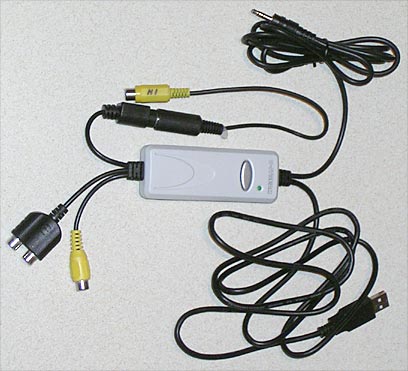 | With this small Xpert V-Stream Videograbber USB2.0, a notebook and freeware VirtualDub one directly can record a AVI-video on the notebook and replay all half-images later step by step. So the accuracy of an event-time is +/- 10ms.
Manufacturer: www.kworld.com.tw Distribution Germany: www.lechner-cctv.de Distribution Austria: www.oe2tzl-atv.at |
This sequence of 6 half-images was summarized on 3 frames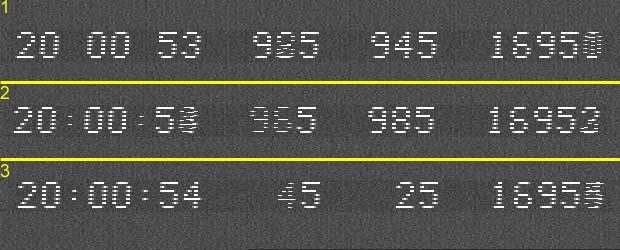 |
The accurate time allocation of the 6 half-images and the collection as 3 frames |
Image 1 20h 00m 53,945s +/-20ms (20:00:53,925 - 20:00:53,965) UTC Image 2 20h 00m 53,985s +/-20ms (20:00:53,965 - 20:00:54,005) UTC Image 3 20h 00m 54,025s +/-20ms (20:00:54,005 - 20:00:54,045) UTC
Video format
In astronomy the first digital recording should take place from video always as loss-free as possible and therefore without compression. Only in such a way fine details are not also lost like individual stars in size of one pixel later in the stored frames. That is during recordings of occultation events an absolute necessity. Thus the various MPEG formats are not useful at digital recording.
The conditions mentioned before are reached however with a AVI fullformat (720x576 with 25fps), with which the luminanz information (brightness information) is not compressed. With the format YUV 4:2:2 the brightness information Y for each pixel with a resolution of 8 bits (256 stages) is sampled. The Chromavalues UV are sampled horizontal only for each second pixel in the line, but vertically in each line with 8 bits. This Chromavalues UV are not necessary for mono chrome video and are wasting a lot of memory and data bandwidth. But there is unfortunately no format, which notes only the Luminanzinformation Y in the age of the colour television. Therefore the AVI format YUV represents 4:2:2 still one of the best possibilities of the digital video recording.
Amount of video data
During the recording in the AVI format YUV 4:2:2 a data set of 16 bit per pixel will be generated and so in PAL (720x576 with 25fps) approximately 20 megabyte per second has to be stored. Hence it follows that with external recording devices only interfaces such as USB2.0 or IEEE 1394 (Firewire) are able to transport these data sets without loss in the Notebook or PC. Inside the computer system there is however a further bottleneck for the data stream. The hard disk must be able to handle this data stream over the entire recording duration without holdup. Only the newest generations of hard disks are really able to make this job. In Notebooks only hard disks with 5400 Upm or more are still sufficient. Also an accordingly large cache of the hard disk helps to prevent numerous frame losses (dropped Frames). Already after few minutes data sets of several gigabyte develop. Since each hard disk becomes ever slower when writing from the outside inward, the capacity should be selected accordingly big. Also a very fast hard disk can get speed problems under 15 per cent free storage. But much more important is a defragmented hard disk. I have seen a fast harddisk with about 50 Gigabyte free space and dropping video frames during recording because of permanent write head movements due to high fragmentation. So defragmentation should be done periodically on a hard disk.
Lossless video data compression
Since April 2006 I know about a very fast video codec which can lossless compression a YUY2 4:2:2 format nearly by a factor of 3 in realtime. So only 7.5 megabyte per second has to be stored on harddisk now. This excellent video codec HuffYUV works very well in the also excellent videosoftware VirtualDub. With hardware USB2.0 Videograbber Xpert V-Stream and this both software solutions I am able to accomblish video harddisk recording in realtime and making later time evaluation in half image steps in an accuracy of +/- 10ms. This is a modern method which works without videorecorder and tapes at outside recording. But due to limited harddisk space I can only record for a maximum of about 120 minutes (52GB) at once. Instead of one large video file the data can be split in many small files during recording. So later only few little files of interest have to be archived.
08 February 2007 |
|
Site Home |